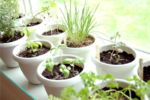Spring into a healthier you: How to grow your own herbs and spices
It is officially Spring, and everyone can feel the excitement in air. Spring brings with it the idea of new beginnings, clean air, and freshness. It’s time to pack away our winter wardrobe and breathe freshness into your home. At this time of year we start to move away from comfort foods and bring fresh ingredients to the forefront of the kitchen. A great way to incorporate freshness into our cooking is the use of herbs and spices to bring flavor and added nutrition to dishes. Herbs come from the leaves and stems of plants; some examples include basil and oregano. Spices come from the bark, seeds, root, or flower of a plant, such as cinnamon (Roak, 2017).
Herbs and spices have been shown to have many health benefits and are an increasingly popular trend to help improve nutritional intake. Herbs and spices contain polyphenols, which are a group of compounds known for their antioxidant and anti-inflammatory effects (Roak, 2017). Polyphenols can help reduce the risk of developing diabetes, heart disease, and cancer (Roak, 2017). Using herbs and spices to flavor food instead of salt and butter can help reduce the risk of developing heart disease. A good tip for including more herbs and spices is to adjust recipes and start experimenting with flavour. Cut the amount of salt, sugar, or butter in half, and increase the amount of herbs or spices to more than the recipe suggests (Dietitians of Canada, 2017). Remember, even small adjustments in the diet will add up and contribute to a healthier lifestyle.
Here is a list of herbs & spices to help flavor your food:
- Basil
- Cinnamon
- Dill
- Cumin
- Oregano
- Curry
- Paprika
- Rosemary
- Thyme
- Tarragon
- Savory
(Dietitians of Canada, 2017)
A great way to incorporate more fresh herbs and spices in your diet is to start an indoor herb garden in your kitchen. This may seem overwhelming at first, but it is quite simple to do and can be fun activity for the whole family to get involved in. Growing plants indoors will also help clean the air in your home and bring some life inside after a long winter. Depending on how you want to start your garden, first decide whether you want to grow your plants from seeds or seedlings. Seeds will take longer to produce anything sizable to cook with, about two to four weeks or more (Fourie, 2017). Seedlings are established plants that you will be able to start using after only a few days of being re-planted. However, seeds are typically less expensive than seedlings, and it can be a lot of fun to watch the plant grow from start to finish.
You can buy seeds or seedlings from your local gardening center, along with soil and small pots to start growing your garden. It is very easy to find the materials you need to start your garden, especially at this time of year when gardening season is just beginning. You can also use recycled jars or cans instead of buying pots to save money. If starting your garden for the first time, the best plants to start with are basil, oregano, mint, rosemary, or thyme (Fourie, 2017).
Tips for starting your own herb garden:
- Start slow and simple – choose 2-3 varieties to start and grow from there
- Don’t over water – only water when the soil is completely dry
- Have good drainage – add pebbles to the bottom of the pot or make sure there is a drainage hole
- Add compost to the soil to provide plants with nutrients
- Harvest from the top of the plant
- Place the garden in the sunniest place possible – the more sun the better
(Fourie, 2017)
With these tips you are well on your way to homegrown freshness. Not only will freshly grown herbs and spices bring lots of flavour to your favourite dishes, but they are healthy for you too. Enjoy!


